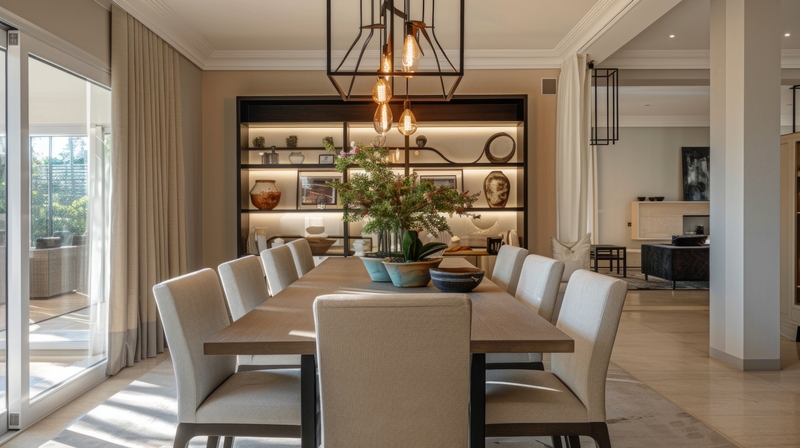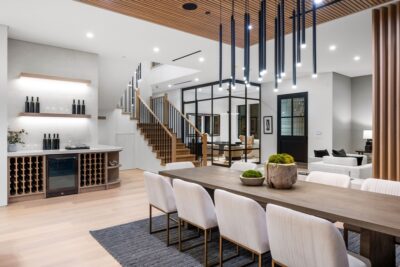
Once a mainstay in American homes, the dining room has apparently become all but obsolete in the modern age. Lately, buyers seem to favor a more contemporary approach to home design—the open floor plan.
This desirable layout often finds walls being torn down and once-separated rooms sharing the same space, offering flexibility and more movement.
This shift in architectural preferences reflects a change in the way we live and use our homes, especially since the COVID-19 pandemic. Many socioeconomic factors, such as the increasingly tricky road to homeownership for many Americans, also contribute to the trend.
However, some experts say that dining rooms are not extinct—like parlors and drawing rooms—and may make a comeback sooner than you think.
Why are dining rooms disappearing from listings?
Home life has dramatically changed since the pandemic. Many owners with separate dining rooms converted the entertaining space into offices, playrooms, or even schools for their kids and have since kept the layouts.
In looking at current listings across the country, Realtor.com® analysts noted that only 25% of properties listed in the U.S. have a dining room. However, this number may not actually reflect the true number of houses with dining rooms— only that realtors aren’t highlighting them in the listing.
And that sort of tells you the whole story right there.
But to drive the point even further, Ana Cvetkovic, principal of Rowhome Design, a Philadelphia-based interior design and home staging firm, explains that many historic rowhouse renovations in the city removed formal dining rooms, replacing them with open-concept living areas.
According to her, an open-concept plan offers a seamless flow from the living area to the kitchen.
“We’ve also become more informal in how we use our homes,” she explains. “Dine-in kitchens are the heart of the home and are more comfortable and casual than dining rooms.”
Less home, less space
Another factor driving the disappearing act of dining rooms is the increase in single people owning homes, many of whom might favor using their space differently. According to the U.S. Census Bureau, over a quarter of all households in the U.S. now have only a single person—the amount having tripled from 1940 to 2020.
Melanie Hönig, designer and co-founder at interior design company SmithHönig, says that as a Southerner, she loves to entertain. Preferring a separate dining room, she actually closed off the open floor plan a previous owner had created in her own home. But she admits she is in the minority.
“On the development side, it seems pretty clear that most buyers still prefer an open floor plan,” Hönig says.

According to her, buyers are now more focused on special touches, like mud rooms or “over-the-top” laundry rooms.
“They want an outdoor space and a ‘wow’ kitchen,” she says. “And honestly, if you’re creating a fabulous kitchen, you want to show it off, not wall it off.”
Cvetkovic echoes the sentiment, saying that if you consider forgoing a dining room, you should invest that space and budget into creating a grand, showstopping kitchen.
“Clients are asking for massive islands that family and friends can gather around, trading upper cabinets for open shelving that turns kitchenwares into art, and generally aiming to make the kitchen feel like the heart of the home rather than just a place where food is prepared,” she says.
Rising home prices and persistently high mortgage rates also make it difficult for many to buy as much house as their parents did. In turn, optimizing the space as much as possible is key.
Realtor.com expects home prices to continue rising 2025, although at a slightly lower pace of 3.7%. And while it expects rates to tick down slightly in 2025, the 30-year mortgage rate rose to 7.04% for the week of Jan. 16, according to Freddie Mac.
Beyond affordability, there is also a generational shift. Millennials and Gen Z are embracing minimalism and sustainability, leading them to favor homes that don’t feel wasteful, says Ryan Whitcher, CEO and founder of Harmony Home Buyers.
“Dining rooms, often viewed as underutilized space, don’t align with their vision of intentional living,” he says, adding that the influence of co-living models—where shared kitchens and common areas replace private dining spaces—is shaping what the next generation sees as necessary or desirable in a home.
The chances of a comeback for the dining room
But don’t count out the dining room just yet. If you love your dining room set or are looking for a home that features room for an elegant table and chairs, things might just be taking a turn.
“Real estate and interior design trends swing like a pendulum, so it’s only a matter of time before dining rooms become in vogue again,” says Rowhome Design’s Cvetkovic.
She adds that with living expenses on the rise, people have less disposable income to spend on dining out.
“Soon enough, we’ll see people romanticizing formal dining rooms as spaces where they can create restaurantlike experiences at home,” she predicts. “And, for that, people will start seeking dining rooms again.”
Other experts also note a return to formal dining spaces in many new-construction homes, which often boast unique features like built-in bars. These spaces, however, are no longer just a place to eat.
“They’ve become a canvas for personal style and a centerpiece for entertaining,” says Jeremy Smith, a real estate advisor at Engel & Völkers Atlanta. “These spaces also provide an opportunity to showcase design elements like bold wallpapers, statement ceilings, grand chandeliers, or distinctive dining tables.”
Finally, the number of multigenerational homes is increasing as many families reunite under one roof for affordability reasons. According to Pew Research, the number of multigenerational family households “is about four times larger than it was in the 1970s.”
For these households, dining rooms can be essential.
Hönig, who lives in a multigenerational home, says there was another reason beyond cost for this choice of living space.
“We want family to be able to age in place in the most joyful way possible,” she says. “The dining room is an important part of that.”
Yael Bizouati-Kennedy, Realtor.com

